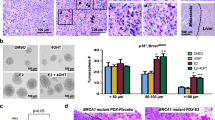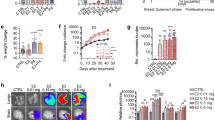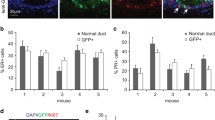Abstract
Purpose
The epidermal growth factor receptor ligand, Amphiregulin, is a transcriptional target of estrogen receptor alpha and is required for pubertal mammary gland development. Previous studies using immortalized human breast cancer cell line xenografts have suggested that Amphiregulin may be an important effector of estrogen receptor alpha during breast cancer development, at least in immune-compromised animals. Here, we evaluate the requirement for Amphiregulin in an immune-competent mouse model which is prone to developing estrogen receptor-positive tumors.
Methods
We have intercrossed mice with mammary-specific mutation of p53 with mice deficient in Amphiregulin in order to assess the requirement for Amphiregulin in the initiation and progression of both estrogen receptor-positive and estrogen receptor-negative mammary tumors.
Results
Deletion of Amphiregulin significantly delayed the onset of palpable mammary tumors and also strongly reduced the proportion of estrogen receptor alpha-positive tumors formed. Upon necropsy, no substantial differences in the prevalence of non-palpable lesions were observed between cohorts, suggesting that the importance of Amphiregulin in mammary tumorigenesis is limited to the post-initiation phase.
Conclusions
This study underlines the importance of the EGFR ligand, Amphiregulin, as a key mediator of estrogen receptor action in breast cancer.





Similar content being viewed by others
Explore related subjects
Discover the latest articles and news from researchers in related subjects, suggested using machine learning.References
Shoyab M, McDonald VL, Bradley JG, Todaro GJ (1988) Amphiregulin: a bifunctional growth-modulating glycoprotein produced by the phorbol 12-myristate 13-acetate-treated human breast adenocarcinoma cell line MCF-7. Proc Natl Acad Sci USA 85(17):6528–6532
Martinez-Lacaci I, Saceda M, Plowman GD, Johnson GR, Normanno N, Salomon DS, Dickson RB (1995) Estrogen and phorbol esters regulate amphiregulin expression by two separate mechanisms in human breast cancer cell lines. Endocrinology 136(9):3983–3992
Berquin IM, Dziubinski ML, Nolan GP, Ethier SP (2001) A functional screen for genes inducing epidermal growth factor autonomy of human mammary epithelial cells confirms the role of amphiregulin. Oncogene 20(30):4019–4028
Kenny PA, Bissell MJ (2007) Targeting TACE-dependent EGFR ligand shedding in breast cancer. J Clin Investig 117(2):337–345
Luetteke NC, Qiu TH, Fenton SE, Troyer KL, Riedel RF, Chang A, Lee DC (1999) Targeted inactivation of the EGF and amphiregulin genes reveals distinct roles for EGF receptor ligands in mouse mammary gland development. Development 126(12):2739–2750
Korach KS (1994) Insights from the study of animals lacking functional estrogen receptor. Science 266(5190):1524–1527. https://doi.org/10.1126/science.7985022
Ciarloni L, Mallepell S, Brisken C (2007) Amphiregulin is an essential mediator of estrogen receptor alpha function in mammary gland development. Proc Natl Acad Sci USA 104(13):5455–5460. https://doi.org/10.1073/pnas.0611647104
McBryan J, Howlin J, Kenny PA, Shioda T, Martin F (2007) ERalpha-CITED1 co-regulated genes expressed during pubertal mammary gland development: implications for breast cancer prognosis. Oncogene 26(44):6406–6419
Peterson EA, Jenkins EC, Lofgren KA, Chandiramani N, Liu H, Aranda E, Barnett M, Kenny PA (2015) Amphiregulin is a critical downstream effector of estrogen signaling in ERalpha-positive breast cancer. Cancer Res 75(22):4830–4838. https://doi.org/10.1158/0008-5472.CAN-15-0709
Wijnhoven SW, Zwart E, Speksnijder EN, Beems RB, Olive KP, Tuveson DA, Jonkers J, Schaap MM, van den Berg J, Jacks T, van Steeg H, de Vries A (2005) Mice expressing a mammary gland-specific R270H mutation in the p53 tumor suppressor gene mimic human breast cancer development. Cancer Res 65(18):8166–8173. https://doi.org/10.1158/0008-5472.CAN-05-1650
Olive KP, Tuveson DA, Ruhe ZC, Yin B, Willis NA, Bronson RT, Crowley D, Jacks T (2004) Mutant p53 gain of function in two mouse models of Li-Fraumeni syndrome. Cell 119(6):847–860. https://doi.org/10.1016/j.cell.2004.11.004
Wagner KU, Wall RJ, St-Onge L, Gruss P, Wynshaw-Boris A, Garrett L, Li M, Furth PA, Hennighausen L (1997) Cre-mediated gene deletion in the mammary gland. Nucleic Acids Res 25(21):4323–4330
Rasmussen SB, Young LJ, Smith GH (2000) Preparing mammary gland whole mounts from mice. In: Ip MM, Asch BB (eds) Methods in mammary gland biology and breast cancer research. Kluwer, New York, pp 75–85
Midgley CA, Lane DP (1997) p53 protein stability in tumour cells is not determined by mutation but is dependent on Mdm2 binding. Oncogene 15(10):1179–1189. https://doi.org/10.1038/sj.onc.1201459
Donehower LA, Harvey M, Slagle BL, McArthur MJ, Montgomery CA Jr, Butel JS, Bradley A (1992) Mice deficient for p53 are developmentally normal but susceptible to spontaneous tumours. Nature 356(6366):215–221. https://doi.org/10.1038/356215a0
Carroll JS, Meyer CA, Song J, Li W, Geistlinger TR, Eeckhoute J, Brodsky AS, Keeton EK, Fertuck KC, Hall GF, Wang Q, Bekiranov S, Sementchenko V, Fox EA, Silver PA, Gingeras TR, Liu XS, Brown M (2006) Genome-wide analysis of estrogen receptor binding sites. Nat Genet 38(11):1289–1297. https://doi.org/10.1038/ng1901
Kong SL, Li G, Loh SL, Sung WK, Liu ET (2011) Cellular reprogramming by the conjoint action of ERalpha, FOXA1, and GATA3 to a ligand-inducible growth state. Mol Syst Biol 7:526. https://doi.org/10.1038/msb.2011.59
Lang GA, Iwakuma T, Suh YA, Liu G, Rao VA, Parant JM, Valentin-Vega YA, Terzian T, Caldwell LC, Strong LC, El-Naggar AK, Lozano G (2004) Gain of function of a p53 hot spot mutation in a mouse model of Li-Fraumeni syndrome. Cell 119(6):861–872. https://doi.org/10.1016/j.cell.2004.11.006
Mao SPH, Park M, Cabrera RM, Christin JR, Karagiannis GS, Oktay MH, Zaiss DMW, Abrams SI, Guo W, Condeelis JS, Kenny PA, Segall JE (2018) Loss of amphiregulin reduces myoepithelial cell coverage of mammary ducts and alters breast tumor growth. Breast Cancer Res 20(1):131. https://doi.org/10.1186/s13058-018-1057-0
Drobysheva D, Smith BA, McDowell M, Guillen KP, Ekiz HA, Welm BE (2015) Transformation of enriched mammary cell populations with polyomavirus middle T antigen influences tumor subtype and metastatic potential. Breast Cancer Res 17(1):132. https://doi.org/10.1186/s13058-015-0641-9
Toneff MJ, Du Z, Dong J, Huang J, Sinai P, Forman J, Hilsenbeck S, Schiff R, Huang S, Li Y (2010) Somatic expression of PyMT or activated ErbB2 induces estrogen-independent mammary tumorigenesis. Neoplasia 12(9):718–726. https://doi.org/10.1593/neo.10516
Lofgren KA, Kenny PA (2016) An instructive ductal microenvironment is key for efficient in vivo modeling of estrogen receptor positive breast cancer. Transl Cancer Res 5(S2):S360–362
Chan SR, Vermi W, Luo J, Lucini L, Rickert C, Fowler AM, Lonardi S, Arthur C, Young LJ, Levy DE, Welch MJ, Cardiff RD, Schreiber RD (2012) STAT1-deficient mice spontaneously develop estrogen receptor alpha-positive luminal mammary carcinomas. Breast Cancer Res 14(1):R16. https://doi.org/10.1186/bcr3100
Fluck MM, Schaffhausen BS (2009) Lessons in signaling and tumorigenesis from polyomavirus middle T antigen. Microbiol Mol Biol Rev 73(3):542–563. https://doi.org/10.1128/MMBR.00009-09
Funding
This study was supported by the American Cancer Society (123001-RSG-12-267-01-TBE to PAK) and by the Gundersen Medical Foundation. PAK holds the Dr. Jon and Betty Kabara Endowed Chair in Precision Oncology. MAG was supported by the Norman L. Gillette Jr. Postdoctoral Fellowship in Breast Cancer Research.
Author information
Authors and Affiliations
Corresponding author
Ethics declarations
Conflict of interest
Each author declares that he/she has no conflict of interest.
Ethical approval
All applicable international, national, and/or institutional guidelines for the care and use of animals were followed. All animal experiments were approved by the Institutional Animal Care and Utilization Committee of the University of Wisconsin—La Crosse (Approval #15-15). This article does not contain any studies with human participants performed by any of the authors.
Informed consent
Not applicable.
Additional information
Publisher's Note
Springer Nature remains neutral with regard to jurisdictional claims in published maps and institutional affiliations.
Electronic supplementary material
Below is the link to the electronic supplementary material.
10549_2019_5507_MOESM1_ESM.tif
Supplementary Figure 1: Substantial rescue of mammary outgrowth defect in Areg-/- glands by transgenic expression of Trp53R172H. (A) Representative images of inguinal mammary glands from either Areg-/-;Tp53+/+;MMTV-Cre (left) and Areg-/-;Trp53+/R172H;MMTV-Cre (right) mice at various ages showing increased ductal development in glands expressing mutant Trp53. The regional extent of ductal elongation is marked with a dashed line in each case. (B) Quantification of mammary ductal area in Areg-/- mice with wild-type (n = 10) and mutant (n = 10) Trp53. (C) Representative PCNA immunostaining of 3 mice of each genotype (all estrus matched) showing higher proportions of luminal cells positive for this proliferation marker in the mice carrying the Trp53R172H allele (TIF 6213 kb)
Rights and permissions
About this article
Cite this article
Meier, D.R., Girtman, M.A., Lofgren, K.A. et al. Amphiregulin deletion strongly attenuates the development of estrogen receptor-positive tumors in p53 mutant mice. Breast Cancer Res Treat 179, 653–660 (2020). https://doi.org/10.1007/s10549-019-05507-2
Received:
Accepted:
Published:
Issue Date:
DOI: https://doi.org/10.1007/s10549-019-05507-2
Keywords
Profiles
- Paraic A. Kenny View author profile




